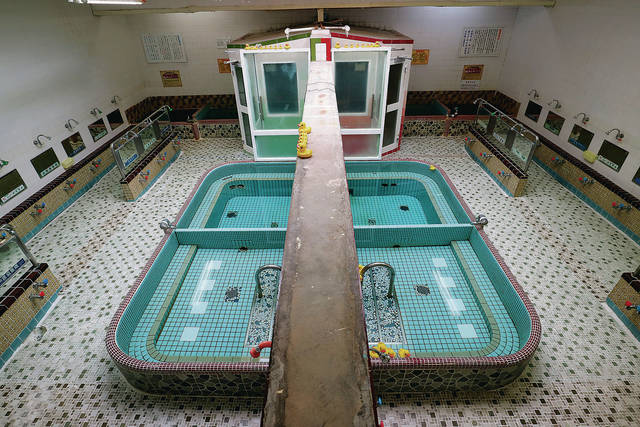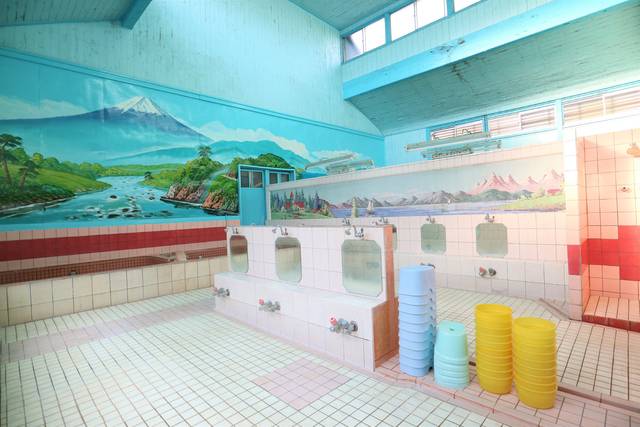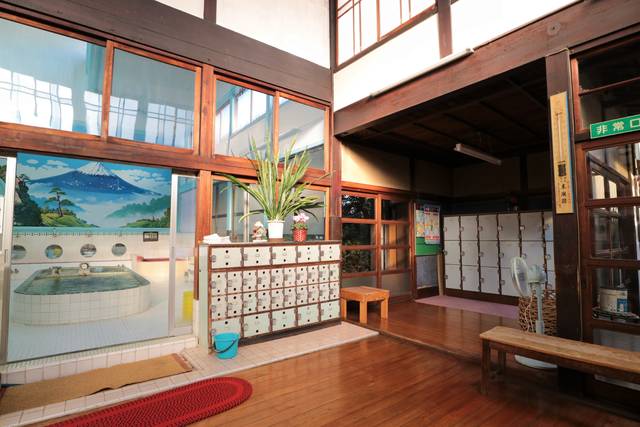The naked truth about Japanese bathhouses

ASSOCIATED PRESS
Mens’ and womens’ baths are separated by a wall at Kyogoku-yu sento, or public bath, in Kyoto. A mural fills a wall at Mikoku-yu onsen, or hot spring bath, in Sumida ward, Tokyo. Sento are bathhouses that use regular water while onsen use natural hot spring water.

ASSOCIATED PRESS
Japan is proud of its bathing traditions. These are washing stations in the Mitake-yu sento, or public bath, in Minami Urawa, Saitama prefecture, Japan.

ASSOCIATED PRESS
This is a changing room in Unsuisen sento, or public bath, in Tokyo, Japan. For many Westerners, though, the fact that these traditions involve being naked with strangers is awkward at best, even though men and women bathe separately.



TOKYO >> Japan is proud of its bathing traditions. For many Westerners, though, the fact that these traditions involve being naked with strangers is awkward at best, even though men and women bathe separately.
On my first trip I tried to wriggle out of a friend’s offer to take me to an onsen, or hot springs resort. I suggested a different town that had an attraction I wanted to see, and thought I was off the hook.
I should have done my research better: That town was famous for its onsen as well.
It turned out for the best, though, because I’ve become a fan. Nothing is more relaxing after a tiring day of sightseeing than a long soak, and you can reassure yourself that you’re experiencing authentic culture at the same time.
Two terms are basic when talking about Japanese baths: onsen and sento. An onsen has natural hot spring water. A sento, usually translated as public bath, typically uses regular water, traditionally heated by burning wood. Tall chimneys for the smoke are one visual symbol of the city sento.
The distinction is noted because various spring waters are supposed to have different health benefits. Onsen are commonly found at hotels and resorts outside the city, but there are about 45 sento in Tokyo, for example, that do have natural spring water.
Don't miss out on what's happening!
Stay in touch with breaking news, as it happens, conveniently in your email inbox. It's FREE!
For the outsider, though, the facilities will look much the same. More important, so are the traditions and etiquette.
Stephanie Crohin is author of a book in Japanese about sento. For three years, she has been the official volunteer ambassador for the Tokyo Sento Association. She has visited over 700 sento across Japan and her book and Instagram feed reveal the beauty of their interiors, where photography is usually prohibited, including many traditional painted murals and immaculate tilework.
She reassures first-timers that with everyone else acting like it’s normal, you will quickly get comfortable. “For some people it is a big challenge to be naked in front of others, but genders are separate, and everybody just doesn’t look and doesn’t care,” she says. “It is the ideal place to forget about complexes!”
Although you won’t have much trouble finding a sento in a city like Tokyo, their numbers are in fact declining. Last year, she says, 40 sento closed in Tokyo. Fifty years ago, there were around 2,700 sento in the city, but now there are around 560, with 2,500 across the country.
One reason sento are closing is that many of their customers are elderly. Now that every home has its own bath, few younger people cultivated the habit. Some sento are trying new strategies to attract customers, including presenting exhibits and events such as concerts and developing English information to attract tourists.
Another innovation: “super sento,” more like day spas with additional facilities and entertainment. One in Tokyo, Oedo Onsen Monogatari, is basically a hot bath theme park with a re-created Edo period townscape.
These may be an easy way in for the first-timer, but if you want to experience authentic local culture, make sure you try a sento too. Just follow the rules so you’ll fit in.
At a typical bath here’s the routine:
>> Leave your shoes in an outside locker.
>> Pay the fee. If you haven’t brought your own soap and shampoo, you can buy small bottles and rent towels. You’ll be given one large towel and a small one.
>> Go through the entrance for your gender. (You might want to memorize the characters for “man” and “woman” in advance.)
>> In the changing room, undress and put your clothes in a locker. This part should feel familiar to anyone who’s been to a gym.
>> Leave the big towel in the locker but take the small one with you. Use it for washing and/or to dry yourself a bit after your bath so you don’t drip onto the changing room floor.
>> The bathroom has individual washing stations. The station may already have a stool, or you can take one and a wash basin from a stack. The basin is the traditional way to wash and rinse yourself, but now there are also hand sprayers.
>> Wash thoroughly. The bath is just for soaking; since the water there is shared, you’re expected to be clean first. Be careful not to splash your neighbors.
>> Tie up long hair. You don’t want it to dangle into the shared bath.
Now you’re ready to soak!
At this point you’ll still be carrying your small towel, which brings up another rule: Never put your towel into the bath. If you’ve seen Japanese bathing on TV, people will usually be covered with towels, but that is only for filming. The most traditional thing to do with the small towel is fold it and rest it on your head while you’re bathing.
Finally, sento and onsen have traditionally prohibited tattoos, which are associated with organized crime. These restrictions are loosening. Sento are usually fine with them, but super sento and onsen resorts may not be, so check in advance.
ON THE NET: dokodemosento.com Opens in a new tab




